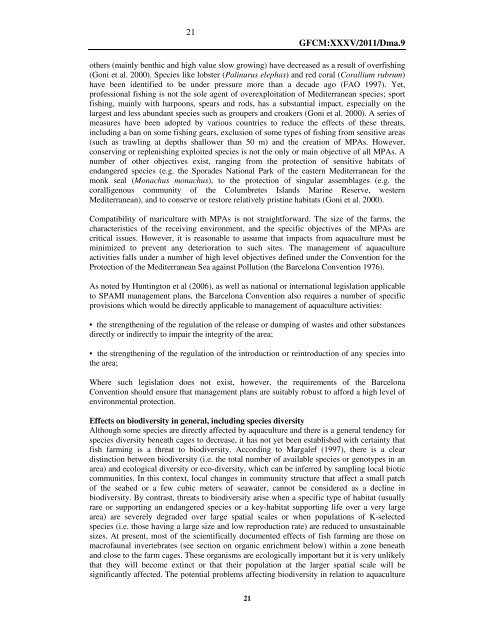Site selection and carrying capacity in Mediterranean ... - FAO Sipam
Site selection and carrying capacity in Mediterranean ... - FAO Sipam
Site selection and carrying capacity in Mediterranean ... - FAO Sipam
Create successful ePaper yourself
Turn your PDF publications into a flip-book with our unique Google optimized e-Paper software.
21<br />
21<br />
GFCM:XXXV/2011/Dma.9<br />
others (ma<strong>in</strong>ly benthic <strong>and</strong> high value slow grow<strong>in</strong>g) have decreased as a result of overfish<strong>in</strong>g<br />
(Goni et al. 2000). Species like lobster (Pal<strong>in</strong>urus elephas) <strong>and</strong> red coral (Corallium rubrum)<br />
have been identified to be under pressure more than a decade ago (<strong>FAO</strong> 1997). Yet,<br />
professional fish<strong>in</strong>g is not the sole agent of overexploitation of <strong>Mediterranean</strong> species; sport<br />
fish<strong>in</strong>g, ma<strong>in</strong>ly with harpoons, spears <strong>and</strong> rods, has a substantial impact, especially on the<br />
largest <strong>and</strong> less abundant species such as groupers <strong>and</strong> croakers (Goni et al. 2000). A series of<br />
measures have been adopted by various countries to reduce the effects of these threats,<br />
<strong>in</strong>clud<strong>in</strong>g a ban on some fish<strong>in</strong>g gears, exclusion of some types of fish<strong>in</strong>g from sensitive areas<br />
(such as trawl<strong>in</strong>g at depths shallower than 50 m) <strong>and</strong> the creation of MPAs. However,<br />
conserv<strong>in</strong>g or replenish<strong>in</strong>g exploited species is not the only or ma<strong>in</strong> objective of all MPAs. A<br />
number of other objectives exist, rang<strong>in</strong>g from the protection of sensitive habitats of<br />
endangered species (e.g. the Sporades National Park of the eastern <strong>Mediterranean</strong> for the<br />
monk seal (Monachus monachus), to the protection of s<strong>in</strong>gular assemblages (e.g. the<br />
coralligenous community of the Columbretes Isl<strong>and</strong>s Mar<strong>in</strong>e Reserve, western<br />
<strong>Mediterranean</strong>), <strong>and</strong> to conserve or restore relatively prist<strong>in</strong>e habitats (Goni et al. 2000).<br />
Compatibility of mariculture with MPAs is not straightforward. The size of the farms, the<br />
characteristics of the receiv<strong>in</strong>g environment, <strong>and</strong> the specific objectives of the MPAs are<br />
critical issues. However, it is reasonable to assume that impacts from aquaculture must be<br />
m<strong>in</strong>imized to prevent any deterioration to such sites. The management of aquaculture<br />
activities falls under a number of high level objectives def<strong>in</strong>ed under the Convention for the<br />
Protection of the <strong>Mediterranean</strong> Sea aga<strong>in</strong>st Pollution (the Barcelona Convention 1976).<br />
As noted by Hunt<strong>in</strong>gton et al (2006), as well as national or <strong>in</strong>ternational legislation applicable<br />
to SPAMI management plans, the Barcelona Convention also requires a number of specific<br />
provisions which would be directly applicable to management of aquaculture activities:<br />
• the strengthen<strong>in</strong>g of the regulation of the release or dump<strong>in</strong>g of wastes <strong>and</strong> other substances<br />
directly or <strong>in</strong>directly to impair the <strong>in</strong>tegrity of the area;<br />
• the strengthen<strong>in</strong>g of the regulation of the <strong>in</strong>troduction or re<strong>in</strong>troduction of any species <strong>in</strong>to<br />
the area;<br />
Where such legislation does not exist, however, the requirements of the Barcelona<br />
Convention should ensure that management plans are suitably robust to afford a high level of<br />
environmental protection.<br />
Effects on biodiversity <strong>in</strong> general, <strong>in</strong>clud<strong>in</strong>g species diversity<br />
Although some species are directly affected by aquaculture <strong>and</strong> there is a general tendency for<br />
species diversity beneath cages to decrease, it has not yet been established with certa<strong>in</strong>ty that<br />
fish farm<strong>in</strong>g is a threat to biodiversity. Accord<strong>in</strong>g to Margalef (1997), there is a clear<br />
dist<strong>in</strong>ction between biodiversity (i.e. the total number of available species or genotypes <strong>in</strong> an<br />
area) <strong>and</strong> ecological diversity or eco-diversity, which can be <strong>in</strong>ferred by sampl<strong>in</strong>g local biotic<br />
communities. In this context, local changes <strong>in</strong> community structure that affect a small patch<br />
of the seabed or a few cubic meters of seawater, cannot be considered as a decl<strong>in</strong>e <strong>in</strong><br />
biodiversity. By contrast, threats to biodiversity arise when a specific type of habitat (usually<br />
rare or support<strong>in</strong>g an endangered species or a key-habitat support<strong>in</strong>g life over a very large<br />
area) are severely degraded over large spatial scales or when populations of K-selected<br />
species (i.e. those hav<strong>in</strong>g a large size <strong>and</strong> low reproduction rate) are reduced to unsusta<strong>in</strong>able<br />
sizes. At present, most of the scientifically documented effects of fish farm<strong>in</strong>g are those on<br />
macrofaunal <strong>in</strong>vertebrates (see section on organic enrichment below) with<strong>in</strong> a zone beneath<br />
<strong>and</strong> close to the farm cages. These organisms are ecologically important but it is very unlikely<br />
that they will become ext<strong>in</strong>ct or that their population at the larger spatial scale will be<br />
significantly affected. The potential problems affect<strong>in</strong>g biodiversity <strong>in</strong> relation to aquaculture
















